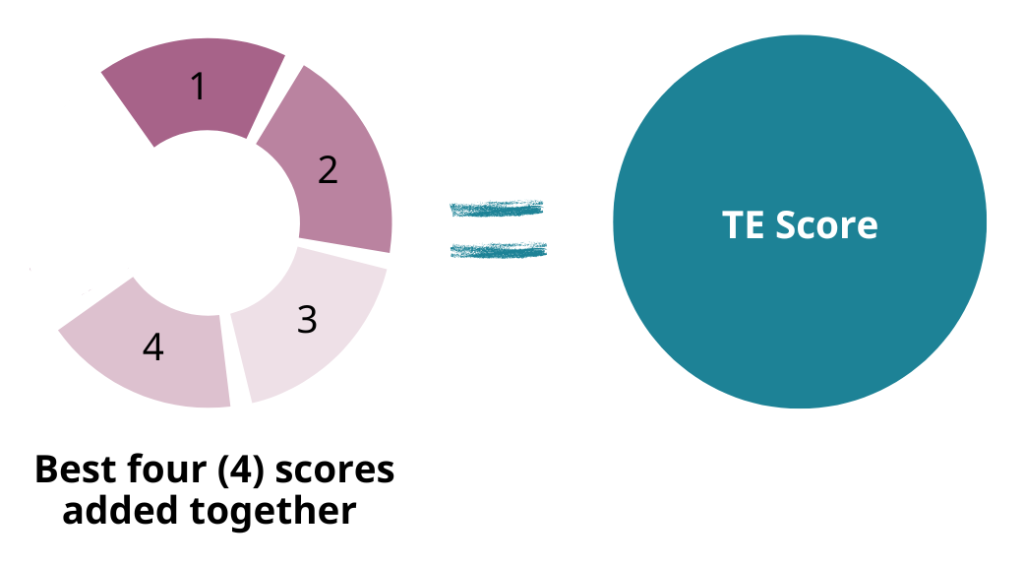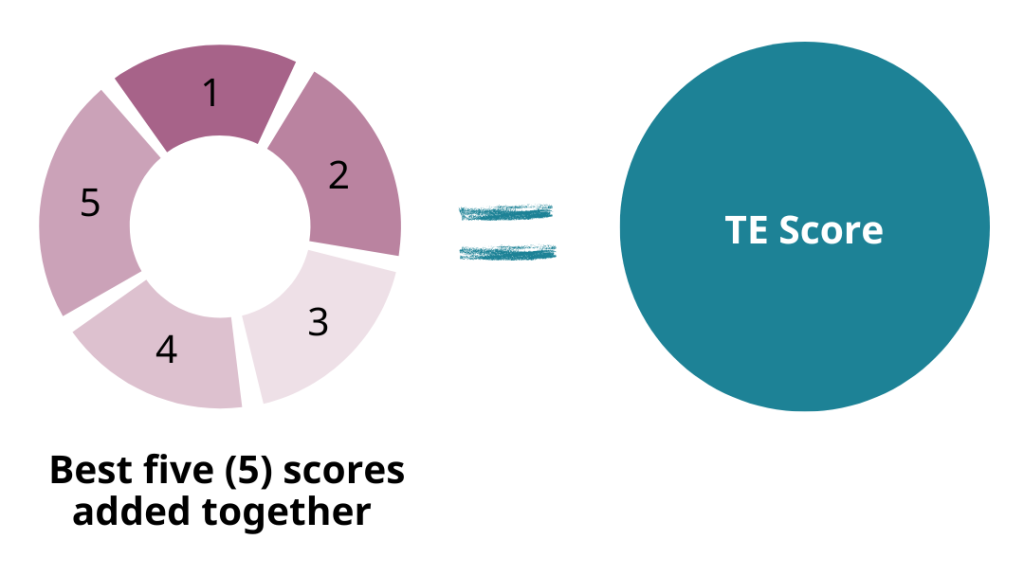Reminder: Read Understanding the ATAR: Student Factsheet first for information about ATAR eligibility.
This TE Score and ATAR Calculation factsheet focuses on how the TE Score and ATAR is calculated after eligibility is determined.
If you are eligible for an ATAR, the following calculations are completed:
- Step 1: Your overall Tertiary Entrance Score (TE Score) is calculated using the combination of your scaled results in applicable courses that will give you the highest possible score. (See Focus on: Course Scaling for information about how course scores are scaled.)
- Step 2: Your overall TE Score is converted to your ATAR based on what position your overall TE Score is when ranked in comparison to other students that year.
How is a TE Score calculated?
Your overall TE Score is a combination of your best results in Level 3 and Level 4 TASC accredited courses (or equivalent level HAP and UCP units or NIAL courses) over two calendar years of senior secondary education. You will need to have successfully completed the courses to be eligible for an ATAR and for the result to be included in a TE Score. For a TASC accredited course, ‘successfully completed’ is an award of Satisfactory Achievement (SA) or higher.
The courses you successfully completed in two years need to provide a sum total of 60 to 75 points for you to be eligible for an overall TE Score.
Different courses/units provide a different amount of points towards the sum total:
- Level 3 and Level 4 TASC accredited courses and NIAL courses = 15 points
- UTAS High Achiever Program (HAP) units = 8 points (a unit with one semester of study)
- UTAS University Connections Program (UCP) units = 8 points (a unit with one semester of study) or 15 points (a unit with one full year of study).
As courses offer different amounts of points and you need a sum total of 60 to 75 points, the number of courses that could contribute to an overall TE Score could be:
- four (4) courses (minimum possible eligibility)
- five (5) courses, or
- five (5) or more courses (including HAP and UCP courses).
Note:
- Check specific UCP units do qualify to be used in your overall TE Score as not all UCP units can be used. UTAS publishes which UCP units can and cannot be used (saying ATAR: Yes or No) in the list on their website.
- If you complete the same course twice (including repeating the same course or completing a course and its replacement course), only one of the course scores can be used towards eligibility for an ATAR and/or in the overall TE Score.
See the details of each possible TE Score calculation scenario on the following pages.
TE Score using Four Courses (minimum possible eligibility)
You can receive an overall TE Score with only four Level 3 and 4 TASC accredited courses over two years (a sum total of 60 points with each course providing 15 points).
It is not recommended that you plan to use only four courses, as your TE Score will be lower than it would be if you had used five courses (as up to 75 points can be used in an overall TE Score). Allowing an overall TE Score with four courses provides a backup arrangement, so you can still receive an ATAR if you don’t do as well as you expected in one of the five courses you planned to contribute to your overall TE Score (for example, you got one course result less than Satisfactory Achievement so can’t use it towards your overall TE Score).

UCP/HAP: 15 point UCP units may be included in the four courses if the unit is listed as counting towards the ATAR (only some UCP units count towards the ATAR, check the list published by the University of Tasmania). HAP units (and some UCP) only provide 8 credit points so one of these units wouldn’t provide enough points (15 points are needed to reach the minimum total of 60 points).
TE Score using Five Courses
Using five Level 3 and 4 TASC accredited courses over two years (a sum total of 75 points with each course providing 15 points) is the most common way to receive an overall TE Score. It means five of your results will be combined for your overall TE Score, which maximises your score (when compared to just four results being combined).

Example A: TE Score using five TASC accredited courses in Years 11 and 12
| Year 11 | Score | Year 12 | Score |
|---|---|---|---|
| Biology (15 points) | 19.8 | Health Studies (15 points) | 21.2 |
| Psychology (15 points) | 11.1 | General Mathematics (15 points) | 11.0 |
| Ancient History (15 points) | 15.9 | Food and Nutrition (15 points) | 10.3 |
| Studies of Religion (15 points) | 12.0 |
The overall TE Score is calculated by taking the best course scores from two years with a sum total of 60 to 75 points. In this case, that is five TASC accredited courses (15 points each) for a sum total of 75 points.
The best course scores are in Health Studies (21.2), Biology (19.8), Ancient History (15.9), Studies of Religion (12.0) and Psychology (11.1) for an overall TE Score of 80.0.
Therefore, the ATAR issued at the end of Year 12 would be based on the ranking of an overall TE Score of 80.0.
TE Score using Five or More Courses, including HAP and UCP Units
HAP or UCP units may be included in an overall TE Score, contributing to the sum total of 60 to 75 points needed. All HAP units qualify to be used in an overall TE Score. Only specific UCP units qualify to be used in an overall TE Score. UTAS publishes which UCP units can and cannot be used (saying ATAR: Yes or No) in the list on their website.
The calculations to use HAP and UCP units in an overall TE Score can be more complicated with proportions being used. TASC will automatically do these calculations and will use one or more HAP or UCP units in your overall TE Score if they are among your best results.
HAP Units
HAP units contribute 8 points to the TE Score sum total. Students typically study two HAP units over one year as a HAP unit is completed over a semester. To include HAP units in an overall TE Score the proportional weighted value of 8/15th is used. Refer to the TE Score calculation example B to see how this works.
UCP Units
UCP units can contribute 8 or 15 points to the TE Score sum total. Full-year UCP units provide 15 points and one semester units provide 8 points.
As a 15 point UCP unit is worth the same as a Level 3 or 4 TASC accredited course it can be used interchangeably/instead of a Level 3 or 4 TASC accredited course in an overall TE Score.
To include an 8 point UCP unit in an overall TE Score, the proportional weighted value of 8/15th is used. Refer to the TE Score calculation example B to see how this works.
Example B: TE Score calculation using five or more courses (including HAP)
| Year 11 | Score | Year 12 | Score |
|---|---|---|---|
| Physical Sciences (15 points) | 11.0 | English (15 points) | 16.9 |
| Biology (15 points) | 20.1 | Biology of Plants – HAP (8 points) | 12.2 |
| General Mathematics (15 points) | 11.5 | Philosophy (15 points) | 14.8 |
| Chemistry (15 points) | 17.7 |
The TE Score is calculated by taking the best course scores from two years with a sum total of 60 to 75 points. In this case, that is five TASC accredited courses and one HAP unit (using a proportion for the HAP unit and one of the TASC courses) for a sum total of 75 points.
The first five best course scores are in Biology (20.1), Chemistry (17.7), English (16.9), Philosophy (14.8) and Biology of Plants (12.2).
As Biology of Plants is a HAP course with 8 points, the course score must be weighted before it is included in the overall TE Score (8/15th of 12.2 is 6.507).
Therefore, the total points from these first five best course scores is 68 points.
As the maximum of 75 points has not been reached and there are more courses that can be included in a TE Score, another 7 points from the next best course (General Mathematics – 11.5) will be used. The course score is weighted and 7/15th of the score will be used. (7/15th of 11.5 is 5.367).
The total course scores used add up to 81.374. This score is rounded down to the nearest one decimal point (to 81.3).
Therefore, the ATAR issued at the end of Year 12 would be based on the ranking of an overall TE Score of 81.3.
TE Score for Year 13 Students
An overall TE score is based on two calendar years of senior secondary education, so only courses from two of the years of senior secondary study can count.
This could be any two-year combination of Year 11, Year 12 or Year 13 (for example: Year 11 and 13, or Year 12 and 13).
TASC will automatically select your best two years to give you the highest possible TE Score. Pre-Year 11 study of senior secondary courses cannot count towards ATAR eligibility or a TE Score.
Example C: TE Score with Year 13 study
| Year 11 | Score | Year 12 | Score | Year 13 | Score |
|---|---|---|---|---|---|
| Biology (15 points) | 19.8 | Health Studies (15 points) | 0 (PA) | Business Studies (15 point) | 11.5 |
| Psychology (15 points) | 11.1 | Sport Science (15 points) | 0 (PA) | Outdoor Leadership (15 points) | 18.6 |
| Ancient History (15 points) | 15.9 | Sociology (15 points) | 14.9 |
The overall TE Score is calculated by taking the best course scores from two years with a sum total of 60 to 75 points. In this case, that is five TASC accredited courses from Year 11 and Year 13.
The best course scores are in Biology (19.8), Outdoor Leadership (18.6), Ancient History (15.9), Sociology (14.9) and Business Studies (11.5) for an overall TE Score of 80.7.
Therefore, the ATAR issued at the end of Year 13 would be based on the ranking of an overall TE Score of 80.7.

